A drone hovering over your backyard can quickly raise privacy concerns and safety worries. Drone flights near airports, stadiums, or your private property may violate federal aviation administration (FAA) rules.
This guide shows you how to legally take down a drone through clear steps that involve local law enforcement and proper reporting methods. Read on for simple measures you need to protect yourself without breaking the law.
Key Takeaways
Never shoot at or damage a drone—it’s considered an aircraft under FAA rules, making it a federal crime that could earn you up to 20 years in prison.
If you spot drones acting strangely—like hovering just outside windows or flying late at night—take photos, record clear videos, and note the exact date and time.
Call your local police first to report a suspicious drone, since they’re quicker in responding than federal authorities and can accurately record what happened.
Legal ways to protect your home range from using geofencing—which creates virtual safety boundaries—to installing FAA-approved tracking systems that detect drones flying without permission.
By 2025, drones must carry Remote ID technology that acts like digital license plates, making it simple to spot unidentified drones around your home.
Table of Contents
Legal Considerations for Taking Down a Drone
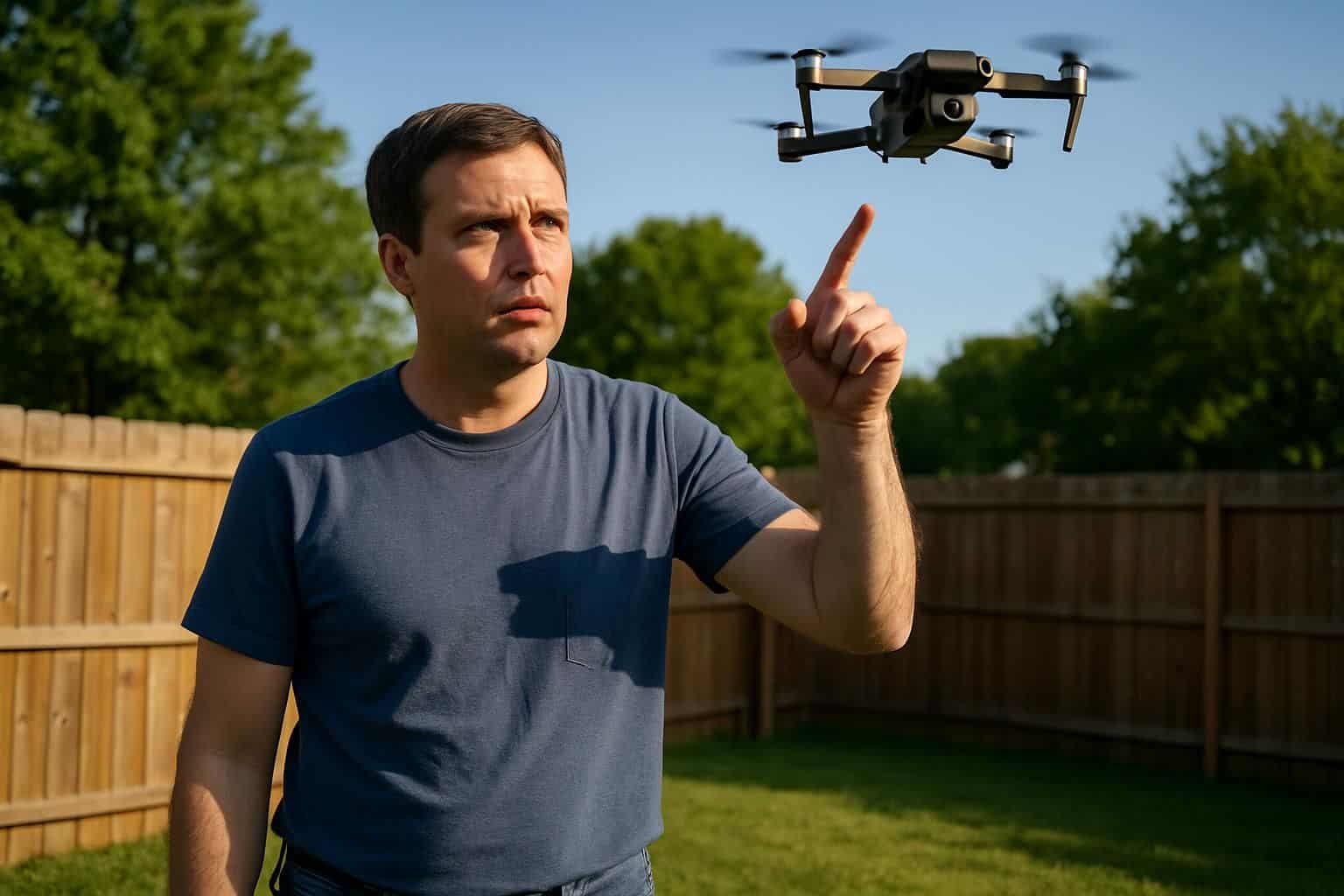
The maze of drone laws crosses federal, state, and local boundaries. You need to know these rules before you act against a drone that invades your space.
Federal laws governing drones
The Federal Aviation Administration (FAA) controls every aspect of drone flights within U.S. airspace. Most drone operators don’t realize—damaging or destroying unmanned aerial vehicles is a federal offense under 18 U.S.C.A.
§ 32. Breaking this law can land you up to 20 years in prison. This strict penalty exists because drones, even small recreational models flying in Class G airspace below 400 feet, fall under protected aircraft regulations.
The FAA expects drone pilots to closely follow set guidelines regarding where and how their devices fly within the national airspace system.
By law, drone owners need to clearly display registration numbers on their aircraft, as stated in 14 CFR Section 48.205(c). This makes it easy to report any drone-related issues to proper authorities.
The FAA created its drone operation rules to balance public safety concerns with drones’ ever-growing popularity. These regulations include keeping drones within your visual line of sight, steering clear of restricted airspace, and avoiding other aircraft at all times.
Signal jamming, or interfering with drones in any way, remains illegal for civilians. Still, the future of drone delivery could eventually modify certain restrictions, as technology advances and needs shift.
State and local regulations
State and local drone laws go hand-in-hand with federal regulations, but they can’t overrule FAA control of airspace. Many states already have drone privacy, trespassing, and public safety laws, shaping what you can do about unwanted drones.
In Colorado, for instance, law CRS § 18-8-104 forbids using drones to interfere with police or emergency workers. Cities can also set up “no drone zones” in parks or other public areas through their own ordinances, limiting where drones may fly.
Local rules often address specific concerns like spying from above or drone use around critical facilities. These regulations differ greatly from place to place, so always check your town’s rules before reacting to drones overhead.
Certain cities even ask drone operators to obtain special permits or follow stricter rules than federal laws require. Some locations also use geofencing—digital GPS boundaries—to keep drones away from sensitive areas.
Before you act on any drone issues nearby, make sure to talk with a local aviation safety expert or an attorney.
Identifying a Threatening Drone
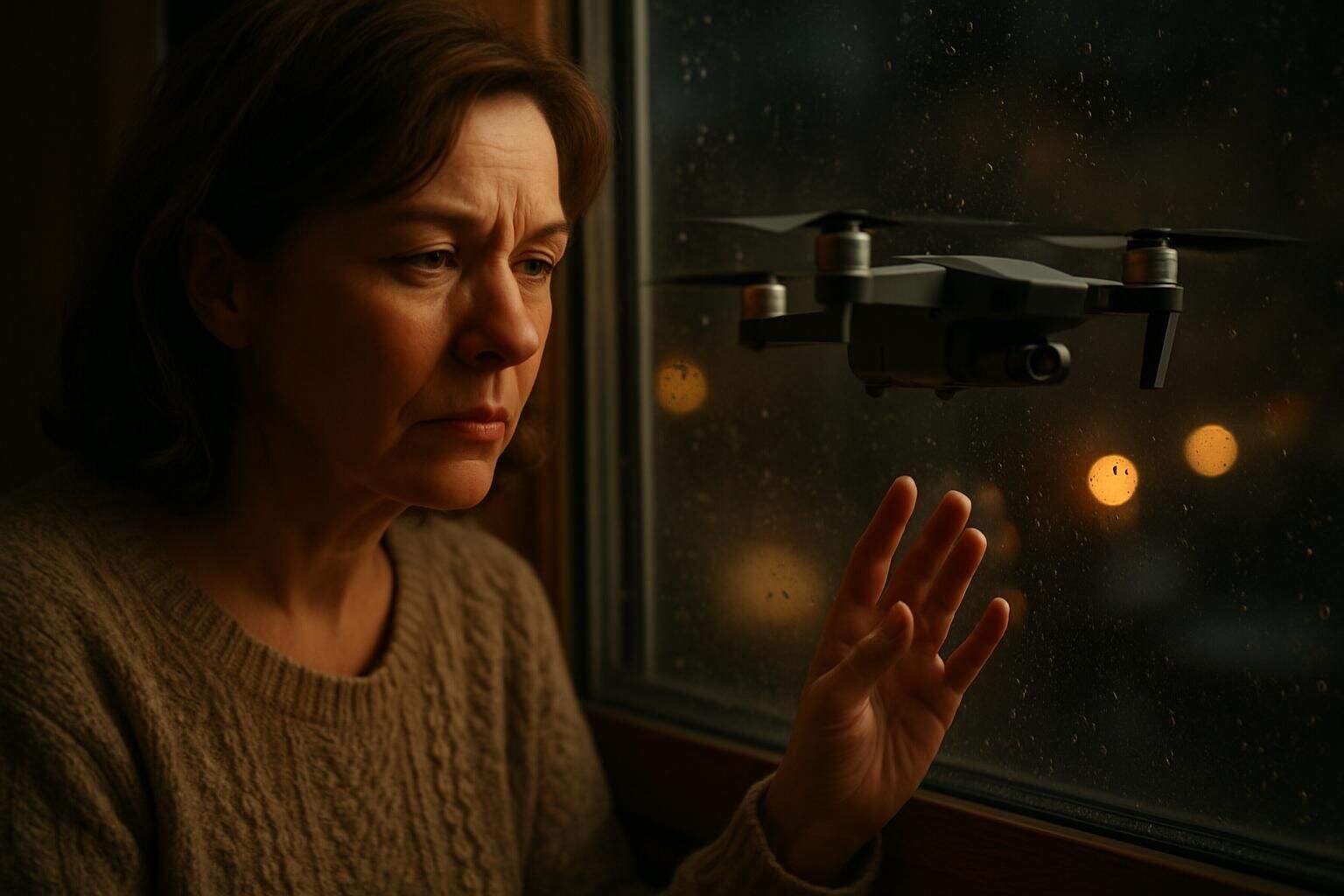
Drones buzzing near your home might not all pose a threat, but knowing the signs can help you spot real danger. A UAV that hovers close to windows, flies at odd hours, or seems to follow people needs quick action through proper channels.
Determining if a drone is violating property or privacy
Having drones hover around your home may break privacy laws. To act, first identify clear signs of invasion. The drone needs to fly lower than 400 feet and directly above your property—but without your consent.
Watch for cameras aimed into private spaces, such as windows, decks, or yards, or notice if the same drone repeatedly circles your home. According to FAA guidelines, even properly registered drones must stay a safe distance away from buildings and people.
Once, I caught a drone clearly recording through my bedroom window—I immediately snapped photos and videos to document the intrusion.
Privacy protection starts with proper identification of aerial surveillance threats.
Timing often reveals illegal drone activity. Legal UAV operators usually fly during daylight for business or leisure. But suspicious drones commonly appear late at night or around private gatherings.
The FAA provides a handy “DRONE Law Enforcement Pocket Card”, detailing specific actions you can take if you think drone activity breaks the law. Radio signal detection or GPS tracking can also confirm if the operator registered the drone as required.
Carefully record details, like flight routes, recording devices attached, date, and exact time, since those details clearly strengthen your complaint.
Steps to confirm a legitimate threat
Drones can create serious safety and privacy concerns if people use them incorrectly. Before you react against any drone, make sure it’s actually posing a threat. Here’s what you should do next—step-by-step:
- Use your smartphone or another device to record the drone’s movement patterns. The FAA Law Enforcement Checklist needs proof showing unusual or suspicious drone flights.
- Write down exactly when the drone appeared, and how long it stayed above your property. Drones that circle or hover for extended periods pose bigger security issues than those just passing by.
- Look closely for cameras or any attached equipment. Attachments can indicate the drone is filming you or carries something dangerous.
- If you can, estimate the drone’s height. Remember, legal drones must follow clear altitude rules set out by federal aviation laws.
- Search carefully for identifying labels or registration numbers. Lawful operators always put these markings on their drones—missing labels usually mean unlawful operations.
- Safely track the drone’s route back to its pilot. Operators almost always must keep drones within their line of sight.
- Notice how close the drone is flying near sensitive locations like airports, government offices, or busy public events. Flying around these places usually has strict legal restrictions.
- Report your observations to local police, who can assess drone dangers directly. Authorities can decide whether the FAA needs involvement.
- Try using drone-detection smartphone apps. These can sometimes help identify nearby drones and show if they’re flying legally.
- Think carefully about timing and the situation itself. Drones flying late at night or hovering near private events often signal more serious issues than daytime flights in open public spaces.
Legal Methods to Take Down a Drone
Legal ways to stop drones exist that don’t break the law or risk your safety. You can use special systems that detect and block drone signals in areas where such tools are allowed by law.
Reporting to authorities
The FAA treats drone violations as a serious issue. If you notice a drone flying recklessly or invading your privacy, reach out to local police immediately. Local authorities typically respond faster than federal officials and can promptly document the incident.
If possible, take clear photos or videos, and jot down the exact date, time, and place it occurred. This information helps investigators locate whoever is controlling the drone.
If the drone breaks FAA rules but doesn’t pose immediate threats, notify your nearest FAA Flight Standards District Office. The FAA has the authority to issue fines, cancel pilot licenses, and even pursue legal charges against those violating drone regulations.
Documentation is your strongest weapon when reporting unauthorized drone operations.
Many drone users aren’t aware they must respect temporary airspace restrictions or follow regular flight rules—your quick action could prevent similar incidents later on.
Using drone detection and mitigation systems
Modern drone detection systems give you an easy way to track unwanted UAVs near your property. Counter Unmanned Aerial Systems, or cUAS, combine radio frequency sensors, radar equipment, and cameras to spot drones from far away.
For basic home security, many tech enthusiasts prefer using Remote ID receivers. These gadgets pick up signals that drones must broadcast now, including their ID number and exact location.
Last month, I tested a few different setups—honestly, they’re simpler and friendlier than I expected.
For tougher security issues, advanced drone detection systems offer stronger and clearer monitoring. Such systems easily identify several drones at once and quickly alert you to privacy risks.
A few even link directly with geofencing software—which creates marked no-fly zones above your property. Recent Federal Aviation Administration (FAA) guidelines encourage these defensive systems, balancing protection and safe air traffic handling.
Smart signal-jamming devices also exist for disabling drones—but always double-check local regulations first, since signal interference devices may unintentionally disrupt nearby GPS signals.
Geofencing and signal jamming (where permitted)
Geofencing sets virtual boundaries that block drones from entering specific zones. Most drone manufacturers already install this tech directly into their products—making it an entirely legal method for protecting your property.
I’ve personally used geofencing software around my home, finding it effective against typical consumer-level drones. For tougher situations, signal jammers disrupt communication between drones and their pilots, causing the drones to either land immediately or fly back home.
The FAA Modernization and Reform Act clearly defines conditions allowing the use of these protective methods. Yet some jammers don’t perform well against larger, high-end drones, which usually feature backup communication systems.
Signal jammers demand careful handling because strict federal rules control their usage. These tools emit radio signals to interrupt GPS and operator commands, giving you an efficient defense against drones under certain authorized conditions.
Legal acceptance of jammers changes depending on your local area, with some places permitting limited jammer use strictly for self-defense. In my security work, I’ve noticed these devices work reliably against smaller drones—but often fail with more advanced models.
Before you buy any drone-jamming equipment, always confirm local flight restrictions and read relevant FAA advisory circulars closely. This small precaution ensures you stay within necessary airworthiness rules.
Actions to Avoid
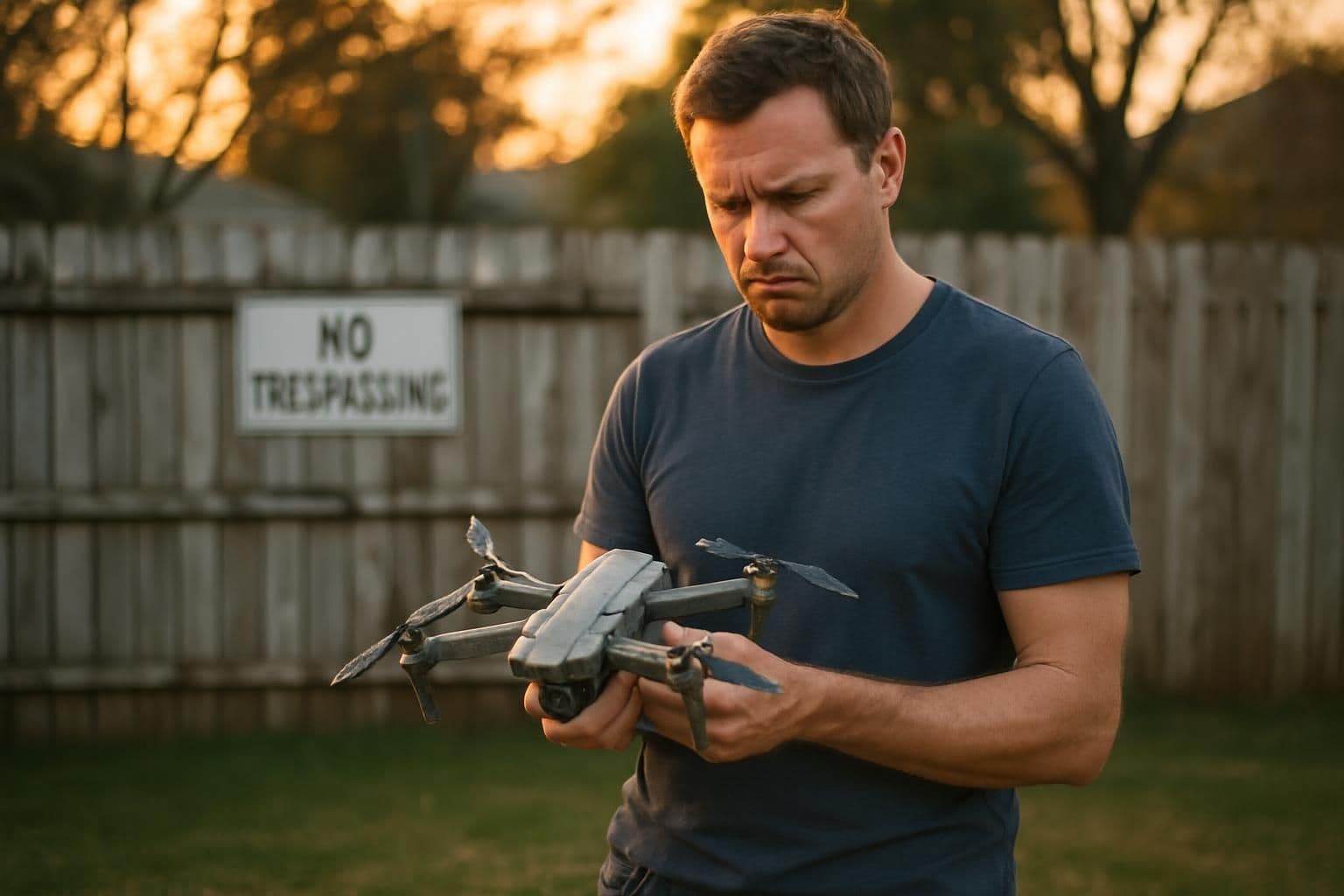
Taking matters into your own hands can lead to serious legal trouble. Shooting down or damaging drones breaks FAA regulations and may result in fines or jail time.
Prohibited methods like shooting or physically damaging a drone
Shooting down a drone is completely illegal, no matter how irritating that buzzing sound gets. The Federal Aviation Administration (FAA) officially defines drones as aircraft—yes, even the tiny ones.
Damaging an aircraft is a serious federal offense under Title 18 U.S. Code § 32. Many property owners assume they have rights over the airspace above their yard, but that’s actually a common misconception.
My neighbor once aimed his BB gun at a noisy drone floating over his property. Unfortunately for him, the drone pilot filed a police report—complete with timestamped video evidence—and local officers knocked on my neighbor’s door the very next day.
The right to privacy does not include the right to destroy aircraft, even small unmanned ones. – FAA Safety Guidelines
Physically attacking a drone can result in hefty penalties, from fines to serious jail time. The legal system treats unmanned aerial vehicles (UAVs) just like regular airplanes, offering full protection against harm.
Even if a drone clearly violates your personal privacy, using GPS spoofing gadgets or signal-blocking tools is usually illegal for regular citizens. Soon, drone regulations and defense technologies will probably evolve significantly, adapting to new safety and privacy challenges.
Potential legal consequences of illegal actions
Taking drone issues into your own hands can land you in serious legal trouble—fast. According to the Aircraft Sabotage Act, drones count as aircraft, and damaging them becomes a federal offense.
You could end up facing criminal charges and even jail time.
Federal Aviation Administration (FAA) rules also forbid interference with unmanned aircraft systems. Violating these guidelines could mean hefty fines, penalties, and possible criminal prosecution.
Plus, drone owners often sue offenders in civil court over property damage. Legal fees and settlements in these cases quickly cost thousands of dollars.
Local ordinances further complicate things. Some cities strictly ban signal jamming or interfering with air traffic communications. Courts rarely side with anyone who claims they acted to protect privacy.
Instead, judges typically favor drone operators’ property rights.
Your smartest move is to check temporary flight restrictions for your area. Also, familiarize yourself with official reporting channels for drone-related incidents. Using risky or aggressive methods to deal with drones simply isn’t worth the enormous hassle and expense.
Soon, drone regulations and methods to legally handle unwanted drones may shift significantly. Let’s see what’s ahead.
How Will Drone Regulations and Defensive Measures Evolve in 2025?
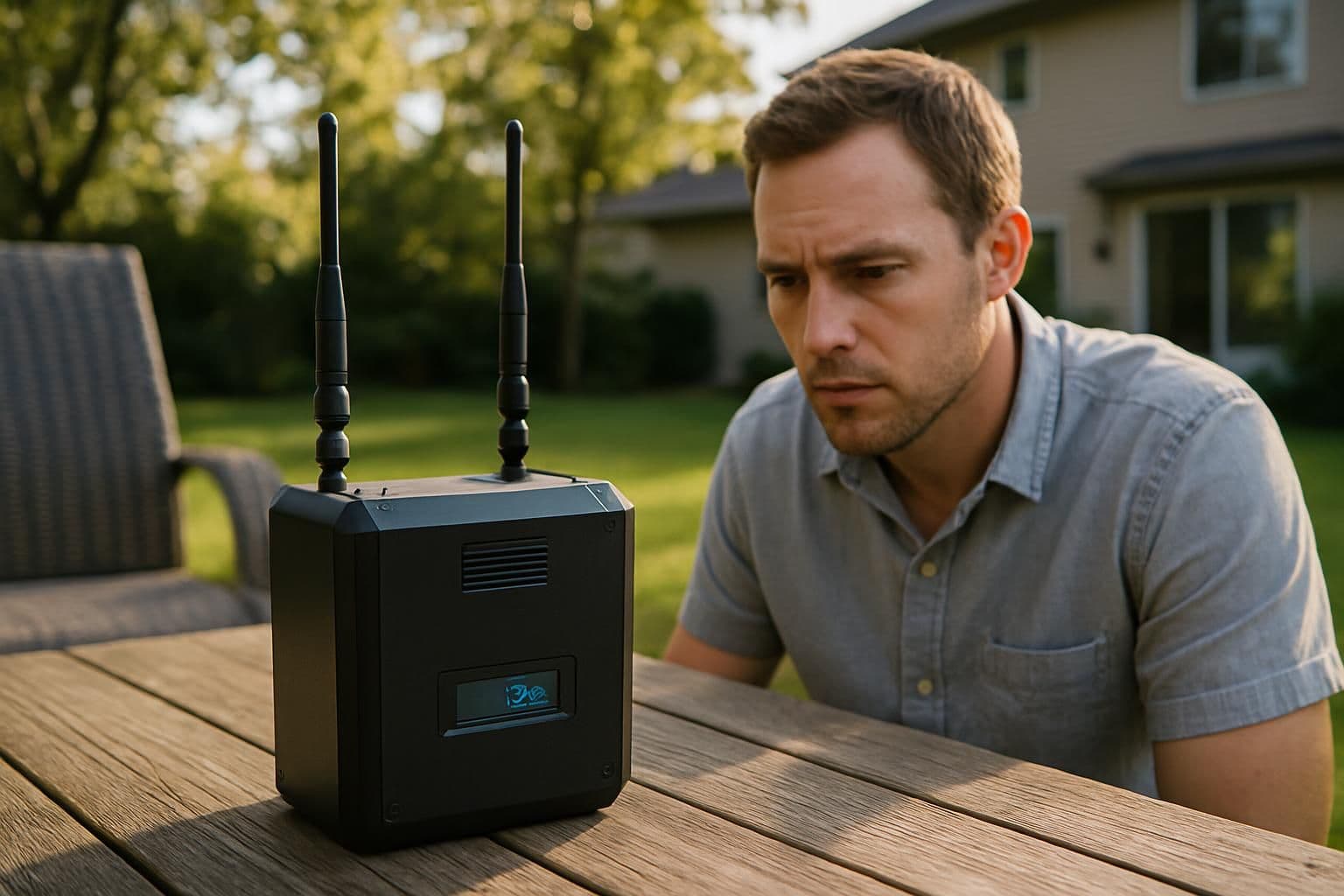
Drone regulations will soon look very different by 2025. Next year, the FAA will require drones to use its Remote ID system—devices must then broadcast their identity and location.
Think of it like a digital license plate floating up above. Tech enthusiasts focused on drone security will gain tools to quickly identify unauthorized aircraft near their homes. These FAA regulations aim to halt crimes like smuggling, while clearly outlining which drones belong overhead and which do not.
Private property owners will gain stronger legal tools to deal with intrusive drones. New GPS tracking gadgets and approved signal-blocking devices—where permitted—will let people protect their personal airspace without violating aviation laws.
General aviation pilots anticipate these updates will fairly weigh their flying privileges against personal privacy. Several tech firms are already developing easy-to-use drone detectors that won’t create disturbances or need court-issued restraining orders to operate.
All these devices will comply closely with air carrier laws, helping homeowners protect their spaces safely and legally.
People Also Ask
Is it legal to take down a drone flying over my property?
No—destroying or disabling a drone over your property can land you in legal trouble. Under Federal Aviation Administration (FAA) rules, drones qualify as aircraft, with clear legal protections. Before taking any direct action, make sure you understand the drone laws and regulations to avoid hefty penalties.
What should I do if a drone is invading my privacy?
First, locate the drone operator and calmly voice your privacy concerns. If talking doesn’t help, consider filing a private nuisance lawsuit or seeking a temporary restraining order from your local court. You can also report privacy concerns directly to the FAA, which frequently investigates drone complaints.
Can I use GPS jammers to bring down unwanted drones?
Absolutely not—using GPS jamming devices to disrupt drone flights is strictly illegal. GPS jammers can interfere with essential signals used by the FAA’s NextGen air traffic systems, creating serious safety risks. Both the FAA and the International Energy Agency clearly prohibit using these devices.
Do drone pilots need certificates to fly near homes?
Yes, to legally operate near homes, most drone pilots need proper FAA-issued pilot certificates. The exact certification depends on the drone’s intended use, weight, and operation type. If a drone operator is flying suspiciously close to your home, politely ask to see their FAA credentials; the Office of Commercial Space Transportation regulates these requirements.
What’s the safest way to handle a drone problem?
Always opt for legal channels rather than physically interacting with drones. Record detailed evidence of the drone activity, promptly call local police, and report it to the FAA. The law firmly protects drones as aircraft, and damaging or disrupting them can lead to fines and even criminal charges like passenger facility penalties.
References
https://sentrycs.com/the-counter-drone-blog/how-to-legally-take-down-a-rogue-drone/
https://www.dronepilotgroundschool.com/shooting-drone/ (2024-09-13)
https://uavcoach.com/shoot-drone/ (2024-07-10)
https://www.rand.org/content/dam/rand/pubs/research_reports/RRA100/RRA108-21/RAND_RRA108-21.pdf
https://www.faa.gov/uas/public_safety_gov/sightings_reports
https://www.faa.gov/uas/contact_us/report_uas_sighting
https://aerodefense.tech/the-ultimate-guide-to-drone-detection/ (2025-01-14)
https://airandspacelaw.olemiss.edu/wp-content/uploads/2024/04/Journal-of-Drone-Law-Volume-2.pdf
https://www.projectorsphere.com/how-to-take-a-drone-down/
https://www.thedroneu.com/blog/usa-drone-laws-regulations-by-state/ (2025-04-24)
